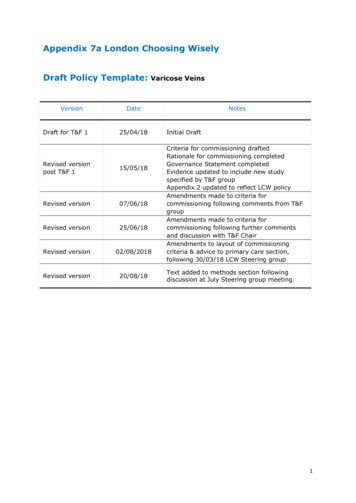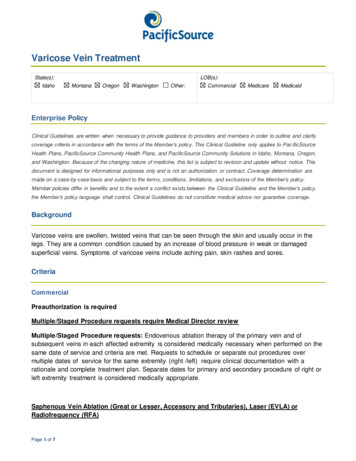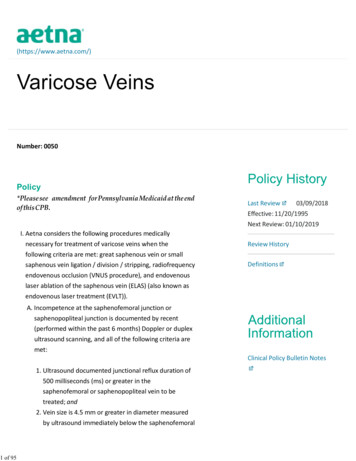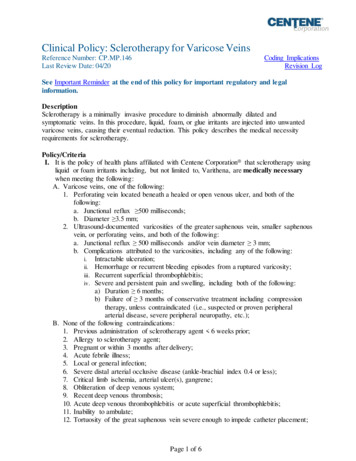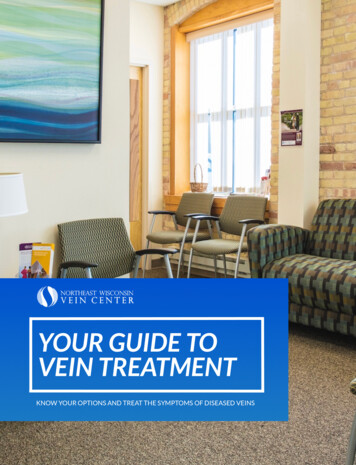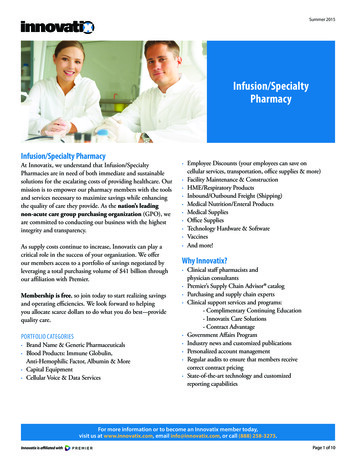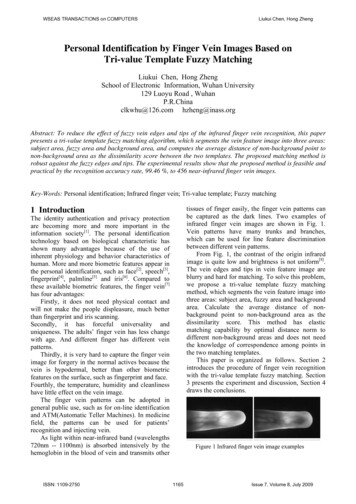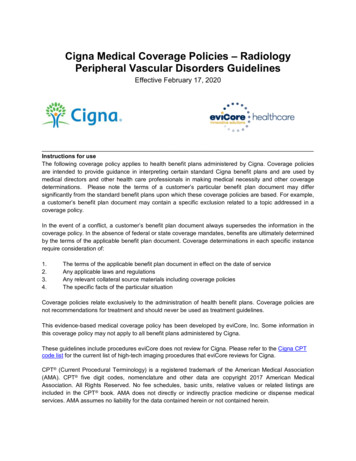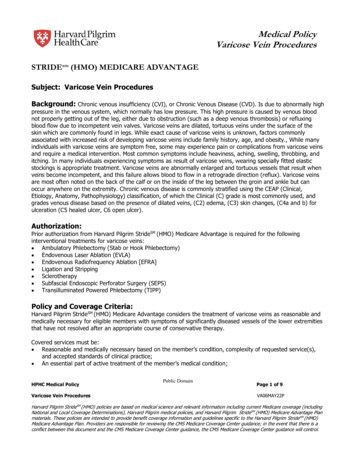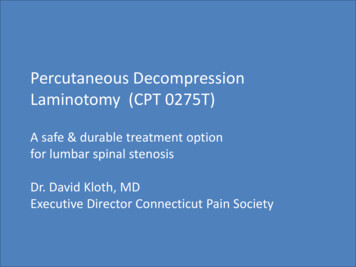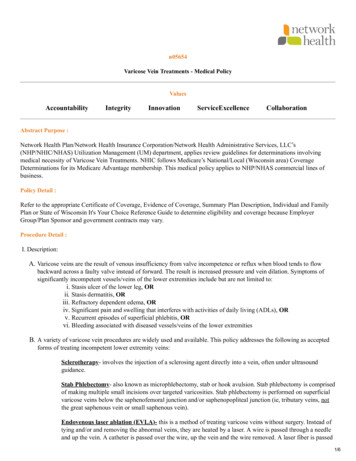
Transcription
n05654Varicose Vein Treatments - Medical ceExcellenceCollaborationAbstract Purpose :Network Health Plan/Network Health Insurance Corporation/Network Health Administrative Services, LLC’s(NHP/NHIC/NHAS) Utilization Management (UM) department, applies review guidelines for determinations involvingmedical necessity of Varicose Vein Treatments. NHIC follows Medicare’s National/Local (Wisconsin area) CoverageDeterminations for its Medicare Advantage membership. This medical policy applies to NHP/NHAS commercial lines ofbusiness.Policy Detail :Refer to the appropriate Certificate of Coverage, Evidence of Coverage, Summary Plan Description, Individual and FamilyPlan or State of Wisconsin It's Your Choice Reference Guide to determine eligibility and coverage because EmployerGroup/Plan Sponsor and government contracts may vary.Procedure Detail :I. Description:A. Varicose veins are the result of venous insufficiency from valve incompetence or reflux when blood tends to flowbackward across a faulty valve instead of forward. The result is increased pressure and vein dilation. Symptoms ofsignificantly incompetent vessels/veins of the lower extremities include but are not limited to:i. Stasis ulcer of the lower leg, ORii. Stasis dermatitis, ORiii. Refractory dependent edema, ORiv. Significant pain and swelling that interferes with activities of daily living (ADLs), ORv. Recurrent episodes of superficial phlebitis, ORvi. Bleeding associated with diseased vessels/veins of the lower extremitiesB. A variety of varicose vein procedures are widely used and available. This policy addresses the following as acceptedforms of treating incompetent lower extremity veins:Sclerotherapy- involves the injection of a sclerosing agent directly into a vein, often under ultrasoundguidance.Stab Phlebectomy- also known as microphlebectomy, stab or hook avulsion. Stab phlebectomy is comprisedof making multiple small incisions over targeted varicosities. Stab phlebectomy is performed on superficialvaricose veins below the saphenofemoral junction and/or saphenopopliteal junction (ie, tributary veins, notthe great saphenous vein or small saphenous vein).Endovenous laser ablation (EVLA)- this is a method of treating varicose veins without surgery. Instead oftying and/or and removing the abnormal veins, they are heated by a laser. A wire is passed through a needleand up the vein. A catheter is passed over the wire, up the vein and the wire removed. A laser fiber is passed1/6
up the catheter so its tip lies at the highest point to be heated (usually in the groin crease). An anestheticsolution is injected around the vein from several tiny needle pricks. The laser destroys the vein walls and thebody naturally absorbs the dead tissue.Radiofrequency ablation (RFA)- is a technique which uses heat to damage tissue and form scar tissue; thescar tissue closes the vein. This technique uses radiofrequency energy (instead of laser energy) to heat up anddamage the wall inside a vein. This closes off a varicose vein in the lower extremity. To facilitate thistreatment the vein needs to be as tightly wrapped around the catheter as possible; therefore, compression isapplied during the procedure and at least one week following the procedure.Mechanochemical ablation (MOCA)- this technique is performed in a similar manner to thermal ablation(EVTA), however, no heat is used. It is an alternative procedure to thermal ablation or for when a thermalprocedure is not possible due to the vein's proximity to a nerve. A special rotating catheter is advanced intothe vein, damaging the vessel prior the injecting the sclerosant agent, resulting in the varicose vein beingclosed.Polidocanol microfoam (PEM)- PEM is the use of injecting a sclerosing agent (usually liquid or foam) totreat small, symptomatic varicose veins in the lower legs. This technique can also be used to treatincompetent great saphenous veins, accessory saphenous veins, and visible symptomatic varicose veinsabove and below the knees. PEM is typically used in combination with compression therapy.Cyanoacrylate adhesive embolization (CAE)- CAE is a new, non-ablative procedure and is the only nonsclerosant treatment for symptomatic venous incompetence/reflux. It is unique in that is does not requirepost-procedure compression. An adhesive is injected and works like “super glue”, bonding to the walls of thevein and ultimately closing the incompetent veins.Tributary Veins - side branches typically of a larger vein such as the saphenous vein.Perforator Veins - veins that allow blood flow from the superficial veins into the deep veins.II. Medical Indications/CriteriaA. The vein treatment technique best suited for everyone depends on their personal clinical and anatomical circumstance.Treatments for symptomatic varicose vein tributaries are compressive sclerotherapy or stab phlebectomy(microphlebectomy).1. Endovenous ablation therapies: each endovenous ablation technique has its advantages and disadvantages.The vein treatment technique best suited for everyone depends on their personal clinical and anatomicalcircumstance. Endovenous techniques have replaced saphenous vein stripping and ligation in many scenarios.2. Thermal tumescent techniques (thermal energy): Network Health considers radiofrequency ablation (RFA)and Endovenous laser ablation (EVLA) procedures medically necessary when:i. Doppler or duplex ultrasound has confirmed significant lower extremity vein incompetence/reflux withretrograde flow of 0.5 seconds duration or greater; ANDii. No evidence of deep vein thrombosis; ANDiii. The individual remains symptomatic despite a six (6)-week trial of conservative treatments.Conservative treatments include, but are not limited to:1. Daily exercise; OR2. Weight reduction; OR3. Periodic elevation of legs; AND4. Use of graduated compression stockings; ANDiv. There is no evidence of vein thrombosis or tortuosity, which would impair catheter advancement; ANDv. The individual’s symptoms for needing any vein treatment are documented and available within thepatient’s medical record prior to performing any procedure, including any inability to tolerateprescription gradient compression stockings and the reason of such intolerance.2/6
3. Non-thermal tumescent techniques: Network Health considers polidocanol microfoam (PEM),mechanochemical ablation (MOCA) and cyanoacrylate adhesive embolization (CAE) medically necessarywhen:i. Doppler or duplex ultrasound has confirmed significant lower extremity vein incompetence/reflux withretrograde flow of 0.5 seconds duration or greater; ANDii. No evidence of deep vein thrombosis; ANDiii. The incompetent veins are no larger than 12mm in diameter; ANDiv. The individual remains symptomatic despite a six (6)-week trial of conservative treatments.Conservative treatments include, but are not limited to:1. Daily exercise; OR2. Weight reduction; OR3. Periodic elevation of legs; AND4. Use of graduated compression stockings; ANDv. Non-thermal tumescent techniques will not be covered if evidence of vein thrombosis or tortuosity,which would impair catheter advancement EXCEPT for PEM.vi. The individual’s symptoms for needing vein treatment are documented and available within the patient’smedical record prior to performing any procedure, including any inability to tolerate prescriptiongradient compression stockings and the reason of such intolerance.4. Sclerotherapy and Stab Phlebectomy procedures: Network Health considers sclerotherapy and/ormicrophlebectomy medically necessary for treatment of symptomatic varicose veins, vein tributaries when:i. Veins measure greater than four (4) mm in diameter (confirmed by ultrasound within the last six (6)months); ANDii. Saphenous reflux is not present or has already successfully treated; ANDiii. The individual remains symptomatic despite a six (6)-week trial of conservative treatments.Conservative treatments include, but are not limited to:1. Daily exercise; OR2. Weight reduction; OR3. Periodic elevation of legs; AND4. Use of graduated compression stockings; ANDiv. The individual does not have a contraindicated condition, including but not limited to:1. Deep venous thrombosis on duplex ultrasound or other imaging test2. Lymphedema or severe peripheral edema in region of procedure3. Advanced peripheral arterial disease4. Known allergy to the sclerosing agent5. Pregnancy6. Local or systemic infection; ANDv. The individual’s symptoms for needing vein treatment are documented and available within the patient’smedical record prior to performing any procedure, including any inability to tolerate prescriptiongradient compression stockings and the reason of such intolerance.III. Coverage:A. NHP/NHAS may extend coverage for varicose vein treatments for the techniques listed above when the criteria aboveare met.B. NHIC follows CMS National Coverage Determinations (NCD) and Local Coverage Determinations (LCD) forapplication to its Medicare Advantage membership. Please refer to the applicable CMS guideline found atwww.cms.gov.IV. Limitations/Exclusions:A. Network Health considers varicose vein treatment not medically necessary for any other indication not meeting thecriteria outlined above.B. Vein procedures for cosmetic reasons are excluded from coverage by Network Health.C. Treatment of asymptomatic veins is considered not medically necessary by Network Health.3/6
D. The following interventional treatments are not considered medically necessary and not covered by Network Health:a. Coil embolization,b. Surgery, endovenous ablation or sclerotherapy on varicose veins that develop during pregnancy (as this tends toresolve or improve after pregnancy),c. Reinjection following recanalization or failure of vein closure without recurrent symptoms,d. Endovenous ablation therapy for patients with several distal arterial occlusive diseases, destruction of deepvenous system and/or an allergy to sclerosant,e. Vein treatments for individuals in a hypercoagulable state.f. Network Health considers no more than three (3) sclerotherapy sessions per leg over a 12-month timeframemedically necessary.Regulatory Citations :UM2Related Documents :CMS, Local Coverage Determination (LCD) for Varicose Veins of the Lower Extremity, Treatment of (L33575)Network Health Internal Clinical Worksheet for Varicose VeinsCPT Codes*:*This list may not be all ion(s) of sclerosant for spider veins(telangiectasia), limb or trunkInjection of sclerosant; single incompetent vein(other than telangiectasia)Injection of sclerosant; multiple incompetentveins (other than telangiectasia), same legInjection of non-compounded foam sclerosantwith ultrasound compression maneuvers toguide dispersion of the injectate, inclusive of allimaging guidance and monitoring; singleincompetent extremity truncal vein (eg, greatsaphenous vein, accessory saphenous vein)Injection of non-compounded foam sclerosantwith ultrasound compression maneuvers toguide dispersion of the injectate, inclusive of allimaging guidance and monitoring; multipleincompetent truncal veins (eg, great saphenousvein, accessory saphenous vein), same legEndovenous ablation therapy of incompetentvein, extremity, inclusive of all imaging guidanceand monitoring, percutaneous,mechanochemical; first vein treatedEndovenous ablation therapy of incompetentvein, extremity, inclusive of all imaging guidanceand monitoring, percutaneous,mechanochemical; subsequent vein(s) treated ina single extremity, each through separate access4/6
364753647636478364793648236483sites (List separately in addition to code forprimary procedure)Endovenous ablation therapy of incompetentvein, extremity, inclusive of all imaging guidanceand monitoring, percutaneous, radiofrequency;first vein treatedEndovenous ablation therapy of incompetentvein, extremity, inclusive of all imaging guidanceand monitoring, percutaneous, radiofrequency;subsequent vein(s) treated in a single extremity,each through separate access sites (Listseparately in addition to code for primaryprocedure)Endovenous ablation therapy of incompetentvein, extremity, inclusive of all imaging guidanceand monitoring, percutaneous, laser; first veintreatedEndovenous ablation therapy of incompetentvein, extremity, inclusive of all imaging guidanceand monitoring, percutaneous, laser;subsequent vein(s) treated in a single extremity,each through separate access sites (Listseparately in addition to code for primaryprocedure)Endovenous ablation therapy of incompetentvein, extremity, by transcatheter delivery of achemical adhesive (eg, cyanoacrylate) remotefrom the access site, inclusive of all imagingguidance and monitoring, percutaneous; firstvein treatedEndovenous ablation therapy of incompetentvein, extremity, by transcatheter delivery of achemical adhesive (eg, cyanoacrylate) remotefrom the access site, inclusive of all imagingguidance and monitoring, percutaneous;subsequent vein(s) treated in a single extremity,each through separate access sites (Listseparately in addition to code for primaryprocedure)ReferencesReferences1. CMS, Local Coverage Determination (LCD) for Varicose Veins of the Lower Extremity, Treatment of (L33575)2. MCG 25th Edition Guidelines, Graduated Compression Stockings A-0336 (AC)3. MCG 25th Edition Guidelines, Saphenous Vein Stripping A-0172 (AC)4. MCG 25th Edition Guidelines, Saphenous Vein Ablation, Laser A-0425 (AC)5. MCG 25th Edition Guidelines, Saphenous Vein Ablation, Radiofrequency A-0174 (AC)6. MCG 25th Edition Guidelines, Sclerotherapy, Leg Veins A-0170 (AC)7. MCG 25th Edition Guidelines, Sclerotherapy Plus Ligation, Saphenous Junction A-0171 (AC)8. MCG 25th Edition Guidelines, Stab Phlebectomy A-0735 (AC)5/6
Disclaimer:Contract language as well as state and federal laws take precedence over any medical policy. Network Health coveragedocuments (i.e. Certificate of Coverage, Evidence of Coverage, Summary Plan Descriptions) outline contractual terms of theapplicable benefit plan for each line of business and will be considered first in determining eligibility. Not all Network Healthcoverage documents are the same. Coverage may differ. Our Medicare membership follows applicable Centers for Medicareand Medicaid Services (CMS) coverage statements including National Coverage Determinations (NCD) and Local CoverageDeterminations (LCD). Please refer to the CMS website at www.cms.gov.Network Health reserves the right to review and update our medical policies on occasion as medical technologies areconstantly evolving. The documentation of any brand name of a test, product and/or procedure in a medical policy is in noway an endorsement of that product; it is for reference only.Network Health’s medical policies are for guidance and not intended to prevent the judgment of the reviewing medicaldirector(s) nor dictate to health care providers how to practice medicine.Origination Date:Approval Date:Next Review Date:06/20/201902/23/202202/23/2023Regulatory Body:Approving Committee:Policy Entity:OTHERMedical Policy CommitteeNHAS,NHPPolicy Owner:Department of Ownership:Revision Number:Tori KirbyUtilization Management4Revision Reason:08/15/2019- new policy 08/20/20-annual review & CPT codes added, the word tuberosity was changed to tortuosity. Thecriteria of no evidence of vein thrombosis or tortuosity, which would impair catheter advancement moved from non-thermaltumescent techniques to thermal tumescent techniques 08/19/2021 - To ensure that changes are tracked in HCC, pushing throughconsent process. Updates will be made to reflect the prior approval and renewal date. 08/19/2021 - annual review & added internalworksheet for varicose veins, added definitions perforators and tributary veins 02/23/22 - consent - no changes to policy content placed CPT codes into table format6/6
vein, extremity, inclusive of all imaging guidance and monitoring, percutaneous, radiofrequency; subsequent vein(s) treated in a single extremity, each through separate access sites (List separately in addition to code for primary procedure) 36478: Endovenous ablation therapy of incompetent vein, extremity, inclusive of all imaging guidance
